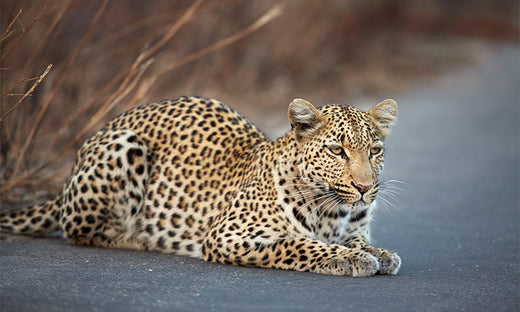
A step-by-step guide to self-drive Kruger for first-time visitors
Share
The Kruger National Park is not only one of the best-known game reserves in Africa, it is also one of the most accessible. You don’t have to join a safari tour to explore the park, you can do it under your own steam. The Van den Berg family, authors of Kruger Self-Drive Routes, Roads & Ratings, share their top tips for planning a self-drive holiday in the park. Follow these steps and you’ll be an experienced park-goer before you know it.

Step 1 Do research
Read as much as you can about the park before you look for accommodation. Get a rough idea of your preferred camps by studying the map – the southern part of Kruger is the most popular and is about five hours drive from Johannesburg and slightly less from Pretoria. The central part is excellent for predators and game in general but you need more time to get there since it is reached along a different route. The northern parts are more remote with less tourist traffic and ideal for those who want to experience the true wilderness feeling. To reach the remote camps is along yet another route and even further from Johannesburg and Pretoria. You could do a circular tour by entering the park in the south, moving slowly towards the north and then drive back to Johannesburg or Pretoria. Alternatively, you could do it the other way round. The ideal is to visit at least three different camps and spend about two nights at each.
Step 2 Decide which camps you would prefer
Each and every camp in Kruger has its own allure and atmosphere. Even the so-called ‘best’ camps can deliver disappointing game drives while unexpectedly good sightings can happen anywhere. It may be possible to choose a camp to suit your expectations and personality. If you are a city person enjoying the buzz of people, then stay at tourist hubs Skukuza or Satara. If you love spending much of the day next to a waterhole, go to Lower Sabie or Mopani. If you are a private person and don’t want to see too many other vehicles, choose one of the private camps such as Bateleur, Sirheni, Shimuwini or Byamiti. If you love breathtaking scenery, stay at Olifants or Letaba. If you want to avoid crowds go to Shingwedzi, Orpen or its satelites. If you like birding and trees, stay at Punda Maria, Pretoriuskop or Berg-en-Dal. If you prefer a higher altitude where it’s generally cooler, then choose Pretoriuskop. Crocodile Bridge Camp on the Crocodile River is a small gem in a game rich area. Or if you like to stay outside Kruger and drive in every day, consider Hazyview, White River, Komatipoort or Malelane area.
Tip: During peak season it may be a challenge to get into the park since day-visitor numbers are restricted. We would recommend trying to stay inside the park if possible.

Step 3 Choose between camping or comfort
Decide whether you want to camp or stay in bungalows. Camping in Kruger is an experience that you will probably never forget. But you need to be prepared. In summer Kruger can be extremely hot, therefore camping during the hottest months (October to February) can be a challenge. When camping, be extra diligent with regards to malaria precautions. Malaria mosquitoes are active between sunset and sunrise.
Malaria is present throughout the year in Kruger, so our advice would be to take prophylaxes regardless of when you are planning to visit Kruger.
Tip: The prophylaxes with the fewest side effects is Malarin/Malerone. It is expensive but worth the money. These days you can also obtain a generic at half the price.
Step 4 Book your accommodation
Accommodation in the more popular camps fills up quickly and bookings should be done well in advance, preferably a year ahead of time. This is especially true during peak periods such as school holidays, Easter weekend, Christmas and the public holidays. Make sure that the camps you choose are within a comfortable drive from each other – check the recommended minimum travelling time before booking. The easiest way to book is through the SANParks online booking system.
Option a: Unless you can get a direct connecting flight into Skukuza or to an airport on the outskirts of the park (Nelspruit, Phalaborwa, Eastgate) you will probably land at OR Tambo International Airport, rent a car and drive to Kruger. Allow anything between five and nine hours to get to Kruger, depending on the entrance gate you are aiming for. Once inside the park you may have to drive quite a distance to the camp for your accommodation. The speed limit in the park is 50km/h on the main roads and 40km/h on the back roads. Allow for time to spend with special sightings along the way.
Option b: You can fly directly into Skukuza from OR Tambo International or to an airport on the outskirts of the Park where you can arrange to pick up your rented car.
Step 6 Choose the right vehicle
The most comfortable ride is undoubtedly a 4×4 as you will coast over the gravel roads without feeling every bump. Off-road and high-clearance vehicles also offer a command viewing position, ideal for scanning the bush. That said, you can visit Kruger in a car of any size, though a car that is slightly larger than the entry level may make you feel more confident when driving past wildlife. If you are not coming in your own vehicle, you can rent one at the airport.
Tip: If you are planning to camp, look into renting a 4×4 vehicle that is set up for camping.
Step 7 Select your entrance gate
Your choice of an entrance gate obviously depends on the first camp you are planning to visit. The closest entrance gate coming from Johannesburg/Pretoria is Malelane Gate. The most popular are Phabeni and Paul Kruger gates. Orpen Gate is the closest to the central parts of Kruger while Phalaborwa Gate is recommended for the northern camps. Both Numbi and Punda Maria Gates pass through long stretches of rural villages with many speed restrictions that slow you down. The average driving speed once inside the Park can be calculated as about 25km/h (allowing for sightings). Avoid arriving too late at the entrance gate if you still have a long way to drive to your camp.

Step 8 Go on a game drive
When going on game drives in Kruger, leave early in the morning when gates open or soon thereafter. Most animals are active at first light, and the best sightings in Kruger are normally achieved within the first hour of the day, as well as the last hour. These are the times that animals are most active. In the middle of the day most animals rest, so follow their example. Take a rest in the middle of the day so that you can do your game drive during the best times of the day.
Step 9 Driving behaviour
Drive slowly. But not too slowly. The best speed is to drive between 20 and 30km/h. Keep your eyes on the bush next to the road and look through the bushes instead of just at them.
Buy a good map or book to find your way around the park. Also get a guide to the mammals and birds of Kruger to enhance your game drive experience – www.hphpublishing.co.za is a good resource of books about Kruger.

Step 10 Respect animals, they have the right of way
Especially those that are bigger than your car. Elephants can be dangerous so keep your distance. Most animals are unpredictable and although one can learn how to approach them successfully over time, it is very difficult for a first-time visitor to Kruger to judge an animal’s mood. But if you respect the animals, they will respect you.
Never feed any animals. Never get out of your car – even leaning out of your window can be a dangerous thing to do. Rather sit back, relax and enjoy the sightings!

2 comments
I enjoyed the last part : Step 10 Respect animals, they have the right of way – Thank you for a great article. – https://krugerbookings.com/
This is great. Thanks for sharing